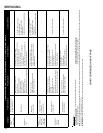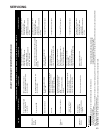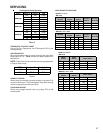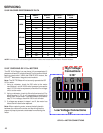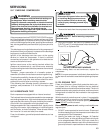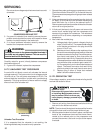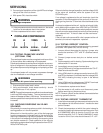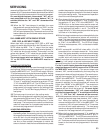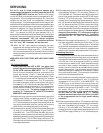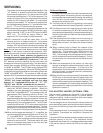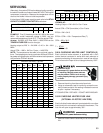
SERVICING
52
3. Check the temperature at which the control opens its
contacts by raising the temperature of the control. Part
# 0130M00009P which is used on 2 and 2.5 ton units
should open at 60°F ± 5°F. Part # 0130M00001P which
is used on 3 thru 5 ton units should open at 75°F ± 6°F.
4. If not as above, replace control.
S-26 CHECKING HEATER LIMIT CONTROL(S)
(OPTIONAL ELECTRIC HEATERS)
Each individual heater element is protected with an auto-
matic rest limit control connected in series with each ele-
ment to prevent overheating of components in case of low
airflow. This limit control will open its circuit at approximately
150°F. to 160°F and close at approximately 110°F.
WARNING
Disconnect ALL power before servicing.
1. Remove the wiring from the control terminals.
2. Using an ohmmeter test for continuity across the nor-
mally closed contacts. No reading indicates the control
is open - replace if necessary. Make sure the limits are
cool before testing.
IF FOUND OPEN - REPLACE - DO NOT WIRE AROUND.
S-27 CHECKING HEATER ELEMENTS
Optional electric heaters may be added, in the quantities
shown in the spec sheet for each model unit, to provide
electric resistance heating. Under no condition shall more
heaters than the quantity shown be installed.
HIGH VOLTAGE!
Disconnect ALL power before servicing
or installing. Multiple power sources
may be present. Failure to do so may
cause property damage, personal injury
or death.
1. Disassemble and remove the heating element(s).
2. Visually inspect the heater assembly for any breaks in
the wire or broken insulators.
3. Using an ohmmeter, test the element for continuity - no
reading indicates the element is open. Replace as
necessary.
S-40 MBR/AR*F ELECTRONIC BLOWER
TIME DELAY RELAY
The MBR/AR*F contains an Electronic Blower Time Delay
Relay board, B1370735. This board provides on/off time
delays for the blower motor in cooling and heat pump heating
demands when “G” is energized.
During a cooling or heat pump heating demand, 24Vac is
supplied to terminal “G” of the EBTDR to turn on the blower
motor. The EBTDR initiates a 7 second delay on and then
energizes it’s onboard relay. The relay on the EBTDR board
closes it’s normally open contacts and supplies power to the
blower motor. When the “G” input is removed, the EBTDR
initiates a 65 second delay off. When the 65 seconds delay
expires the onboard relay is de-energized and it’s contacts
open and remove power from the blower motor.
During an electric heat only demand, “W1” is energized but
“G” is not. The blower motor is connected to the normally
closed contacts of the relay on the EBTDR board. The other
side of this set of contacts is connected to the heat
sequencer on the heater assembly that provides power to
the first heater element. When “W1” is energized, the
sequencer will close it’s contacts within 10 to 20 seconds
to supply power to the first heater element and to the blower
motor through the normally closed contacts on the relay on
the EBTDR. When the “W1” demand is removed, the
sequencer opens it contacts within 30 to 70 seconds and
removes power from the heater element and the blower
motor.
The EBTDR also contains a speedup terminal to reduce the
delays during troubleshooting of the unit. When this
terminal is shorted to the common terminal, “C”, on the
EBTDR board, the delay ON time is reduced to 3 seconds
and the delay OFF time is reduced to 5 second.
Two additional terminals, M1 and M2, are on the EBTDR
board. These terminals are used to connect the unused
leads from the blower motor and have no affect on the board’s
operation.
SEQUENCE OF OPERATION
This document covers the basic sequence of operation for a
typical application with a mercury bulb thermostat. When
a digital/electronic thermostat is used, the on/off staging of
the auxiliary heat will vary. Refer to the installation
instructions and wiring diagrams provided with the
MBR/AR*F for specific wiring connections and system
configuration.
MBR/AR*F WITH SINGLE STAGE CONDENS-
ERS
1.0 Cooling Operation
1.1 On a demand for cooling, the room thermostat ener-
gizes “G” and “Y” and 24Vac is supplied to “Y” at the
condensing unit and the “G” terminal on the EBTDR
board.
1.2 The compressor and condenser fan are turned on and
after a 7 second on delay, the relay on the EBTDR board
is energized and the blower motor starts.
1.3 When the cooling demand “Y” is satisfied, the room
thermostat removes the 24Vac from “G” and “Y”.



